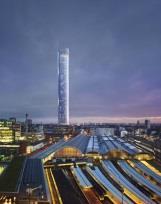Whoever is elected London mayor in three weeks’ time, their top priority will be housing.

This wasn’t the case when I first stood against Ken Livingstone in 2000, but since that first election only 16 years ago, London has grown by a staggering 1.2 million people and is still growing fast. It follows that if we are going to meet the housing challenge we need bold action and in the process to rethink areas of London that have so far been largely untouched and would clearly benefit from investment. Think Shoreditch as a classic example. A decade ago you couldn’t give it away. These days values rival parts of the West End.
Another example is the area around Paddington station where Irvine Sellar is developing a major £1bn mixed-use regeneration scheme. When it was launched last year, all attention focused on his Renzo Piano-designed 72-storey residential tower. Not being involved in it then or now in any way, I personally loved it but its reception was decidedly mixed. Much of the talk was about how the tower would stand out and how it would upset the balance of the area.
As far as I was concerned, one of the virtues of the pencil-thin, elegant design from the architect of The Shard was precisely that it made a statement about this part of west London, which around the station in particular is, frankly, not beautiful. Paddington and Bayswater benefit from some lovely white stucco, which we would all want to protect, not least because it creates some of the densest housing in the city and does so with charm. But Praed Street? Really?
Bakerloo line entrance

What was not talked about half enough was that the scheme also involves investing around £65m to transform the entrance to the Bakerloo line, create a major new public piazza on the east side, re-profile London Street and massively improve the underground and rail connections where Crossrail will, of course, be arriving in 2019. Any user knows the current access to the Bakerloo line is hopelessly inadequate, with gates being closed on a regular basis for safety reasons even without the huge increase in passenger numbers that Crossrail will bring. The ticket hall is pokey and escalators too few.
To get some idea of what a difference the scheme will make, think Tottenham Court Road station. Then take a look at how it’s been transformed and you’ll get some idea of what I’m driving at. The Paddington scheme creates a proper front entrance to the station for the first time, while opening up access to St Mary’s Hospital and massively improving the whole area around Praed Street, which, if you don’t know it, I assure you can hardly be described as beautiful. It’s a great scheme and I’m a huge fan.
Responding to the criticism, Sellar is now preparing a new design that will lower the height of the tower. If it meets the residents’ concerns and still makes the scheme viable then all the better for that, but behind this tale of the trials and tribulations that so often beset developers in London lies a truth we can’t ignore.
By common consent we need to be building at least 50,000 homes a year in London simply to keep pace with demand. So far, both Ken and Boris have failed to do so. The best either has done is little more than half that number. If the next mayor is going to get anywhere near the target, they will need to think big. Look for those parts of the city where private sector investment can transform the mediocre and create world-class liveable space. Towers will sometimes be part of the solution and sometimes they will not. We can get much better densities in certain locations without going skyward. But what we cannot do is nothing. Cities evolve. The Victorians understood that and boldly transformed their London. We ‘New Victorians’ must do the same.
Steve Norris is chairman of the National Planning and Infrastructure Association and of Soho Estates






























No comments yet